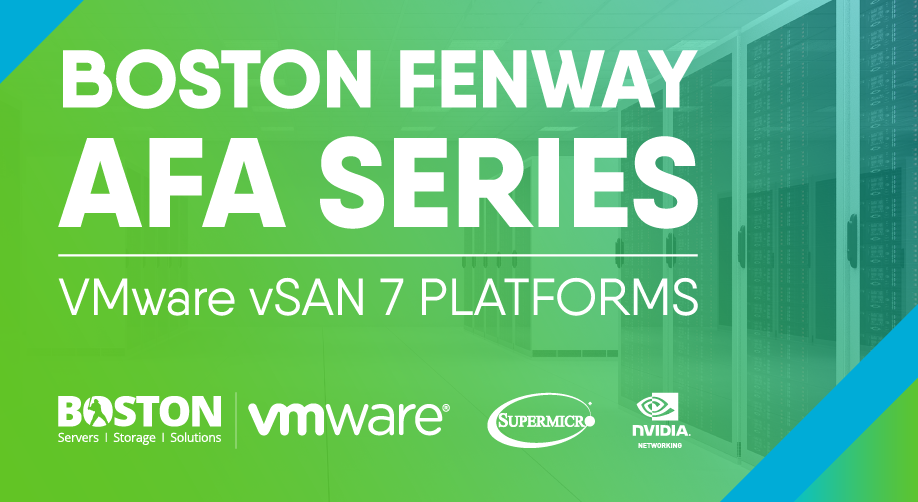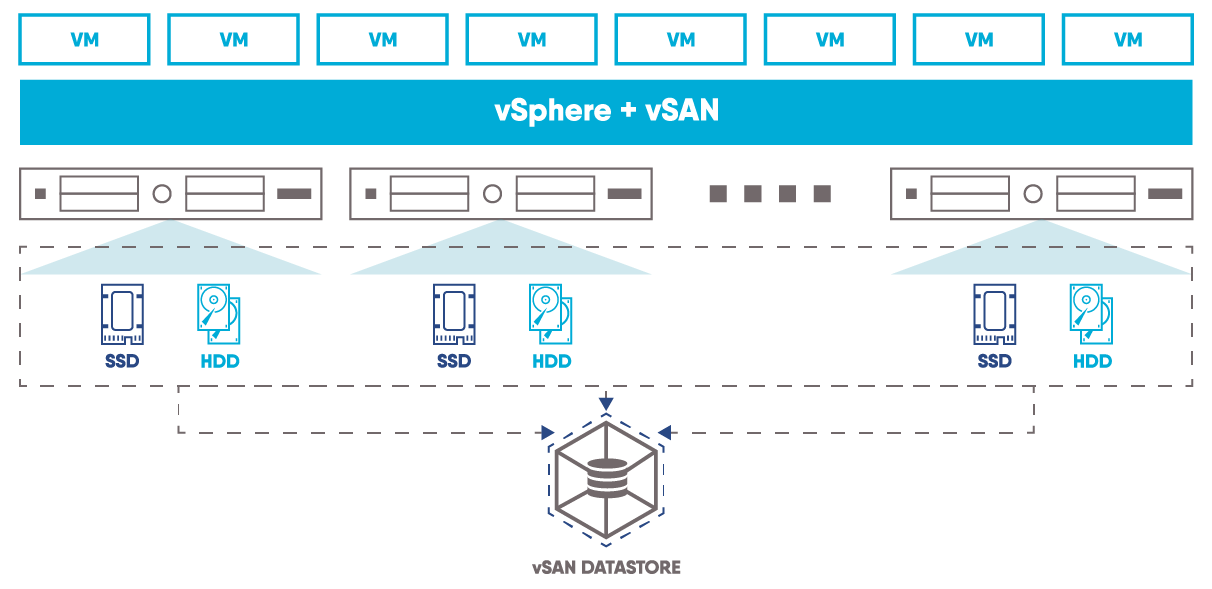
Boston Fenway AFA Series – VMware vSAN 7 Platforms - Featuring Supermicro & NVIDIA Networking
Boston is proud to be a long-standing partner of VMware and have been successfully deploying solutions which integrate key technologies from Supermicro & NVIDIA Networking for many years. Whether it be high-performance, high-capacity, super low latency storage, high-density compute, extreme memory capacity or even vGPU accelerated systems - we have a tested solution to cater your needs.
Utilising vendors with a proven track record for the best of breed products; a combination of VMware software, Supermicro Server & NVIDIA Networking products enables our solutions architects to design unique and innovative fitted platforms to match customer requirements, delivering an exceptional value proposition. Combined with decades of systems integration design, testing and deployment experience from Boston - our solutions are fully tested and validated to perform each and every time. Our team of expert VMware architects and engineers design solutions that are highly resilient yet also provide performance that is simply outstanding.
Setting ourselves aside from our competition too is our 24 hour a day, 365 day a year proof of concept laboratory - Boston Labs; a safe haven where you can replicate a sample test environment and run mirrors of production workloads before committing to purchasing a solution.
What is VMware vSAN, Software Defined Storage (SDS) & Hyper Converged Infrastructure (HCI)
What main points are VMware vSAN, SDS & HCI designed to solve? The main benefit of virtualisation is to achieve greater utilisation of physical hardware, while still maintaining a logically segregated and secure deployment of varied workloads. SDS and HCI take this each one step further, allowing VMware vSAN to offer exceptional value for money and provide a unified management solution making administrators life much easier. We will touch more on that later.
When a physical server is deployed as a virtualisation host, the CPU, memory and PCI-Express capacity will typically be well utilised, however the local storage capacity typically is often left as a lonely, unused and isolated island. In many cases, most of the disk drive bays (or all when using onboard NVME, SuperDOM’s or network to boot ESXi) are empty and often the backplane and any storage controllers present are not utilised. HCI takes these unused slots, fills them with high-performance and high-capacity drives and pools them into hybrid storage for use by a cluster of virtualisation hosts. This means you don’t need to buy an extra enclosure, motherboard, CPU’s, memory, networking, or purchase a separate SAN solution to provide the centralised storage we rely upon for both performance and resilience of IT workloads. This improved utilisation saves both datacentre space and overall power consumption - reducing operating costs. Additionally, overall complexity goes down as the number of vendors providing software and hardware decreases. Costly support agreements and the number of contacts to work with when issues arise are also reduced, often giving just one point of contact and ultimate responsibility to resolve issues with fewer grey areas.

HCI is a cost saving measure and simplifies both complexity and management, but this does not come at the expense of performance or stability. VMware vSAN is a stable enterprise product with the leader in the virtualisation industry standing firmly behind this product. When it comes to performance, by default VMware vSAN automatically places virtual machine objects on the disk groups that are physically within the virtualisation host running that specific virtual machine. The distance between storage and hypervisor CPU is therefore much closer (it can’t get any closer!) than traditional SAN deployments which are often physically remote - reducing latency, increasing IOPs and bandwidth; it really is a rare win/win scenario.
Traditionally storage was fairly unintelligent - a hardware based RAID controller would be configured to control disks, offering a certain level of protection/performance via a RAID level (0,1,5,6,50,60,etc). Multiple logical devices could be created using various levels of protection/performance depending on the number of devices however, if you wanted a single file or object to have more protection or performance, you had to manually move that one file from one logical RAID device to another. What if you wanted a RAID level that hadn’t been configured and you had utilised all your disks? You were stuck with what you had. Also, when a drive failed, RAID controllers generally weren’t smart enough to know the difference between written space and empty space. A ten-terabyte drive with one megabyte of actual data written to it would have to recompose all 10 terabytes worth of unused space (probably zeros) to repair the RAID volume and re-protect that one megabyte of valuable data. In the case of VSAN’s SDS, it knows which objects and therefore blocks that have actually been written and to repair the volume would only require writing the one megabyte to the new disk. This massively reduces rebuild/resilver times and also the risk of a data loss if additional drives fail during that process.
With SDS there is no hardware RAID in use. All the storage devices are presented to vSAN directly and it is under full control. Disk groups, each with their own high-performance SSD or NVME cache device, are created and vSAN will decide where to place VM objects based on the level of protection/performance you have specified - this means a lot less manual movements and administrative overhead. With sufficient VSAN nodes in a cluster, very high levels of data redundancy can be created - up to 8 copies can be used for critical data (stretched cluster) while at the same time other objects can have as few copies as 1 - no redundancy at all, ideal for of scratch or disposable data. This complete object based flexibility is simply controlled via software-based storage policies. If that wasn’t enough, site-to-site replication is available without any additional licensing too! This allows data to be replicated in real-time to a second site, providing a true Disaster Recovery solution with very little implementation work. That’s right; VMware vSAN offers a SDS HCI solution and at the same time have thrown in a site to site replication DR solution for free!
Management of your VMware vSphere virtualisation environment and your VMware vSAN SDS is simple and through the same vSphere/vCenter single pane of glass. There is no need to log into multiple interfaces to monitor and cross reference events to troubleshoot issues. Additionally, vSAN Skyline offers advanced troubleshooting and diagnostics intelligence. When an issue or misconfiguration occurs, Skyline automatically knows about it, provides an alert and information to the administrator enabling them to resolve the issue. Some solutions are even as simple as granting Skyline permission to remediate said issue automatically.
VMware vSAN ReadyNodes and the Boston Fenway AFA Series
VMware vSAN ReadyNodes like the Boston Fenway AFA Series allow for vSAN to be deployed as quickly as possible, using a validated supported hardware configuration. All flash, hybrid, edge, Intel or AMD configuration profiles are available allowing for the rapid creation of a bill of materials likely to suit your needs.
Entirely bespoke configurations are also available which are validated using the extensive VMware Hardware Compatibility List – our VMware architects are trained to select the best elements from our available portfolio and additionally perform in house validation to ensure absolute compatility and stability.
Summary
VMware vSAN is a state of the art SDS HCI solution, with site-to-site replication for all your production and disaster recovery needs. Managed via a single pane of glass with VMware Skyline intelligence to speed up implementation and assist in resolution of support issues. VMware vSAN offers unparralleled full utiliSation of hardware and minimises datacentre costs by reducing footprint and power consumption. Reduced number of vendors and management interfaces reduces support costs and internal training costs respectively. The VMware vSAN ReadyNode program continues the reduction of time to deployment and support considerations through standardisation.
Boston has decades of systems integration design, testing, deployment and support experience across the enterprise and HPC (High Performance Computing) space. Whether it be scientific research, artifificial intelligence/machine/deep learning, cloud compute, high capacity or low latency storage, low latency and/or high bandwidth networking or a general purpose requirement Boston has a solution for all use cases and with our evolving VMware Partnership we can architech, build, deploy, test and support your entire VMware vSphere/vSAN needs or any subset there of.
Boston is a proud VMware Partner and supporter of VMware vSAN. Contact us today on 01727 876100 or email us at [email protected] to discuss your requirements and schedule a proof-of-concept deployment in our certified laboratory to test your production workloads.